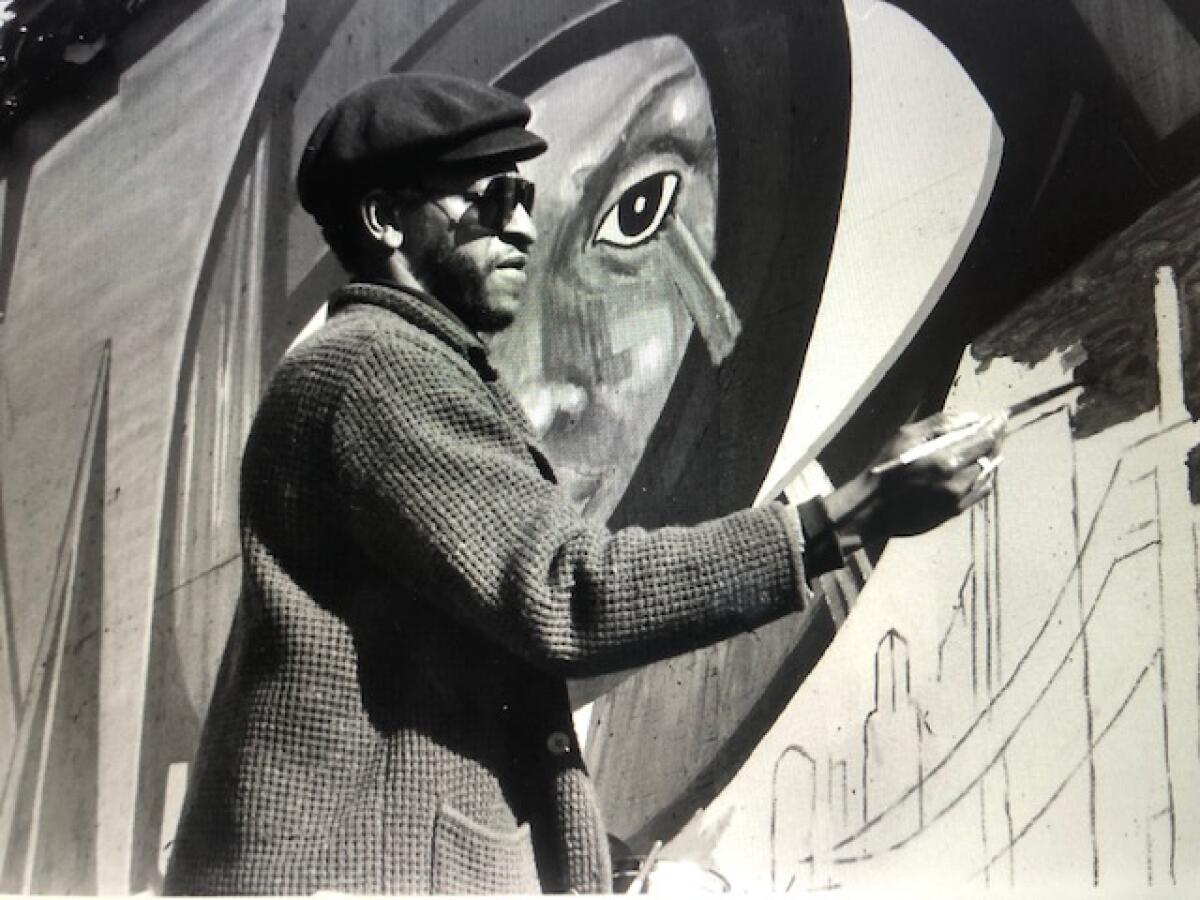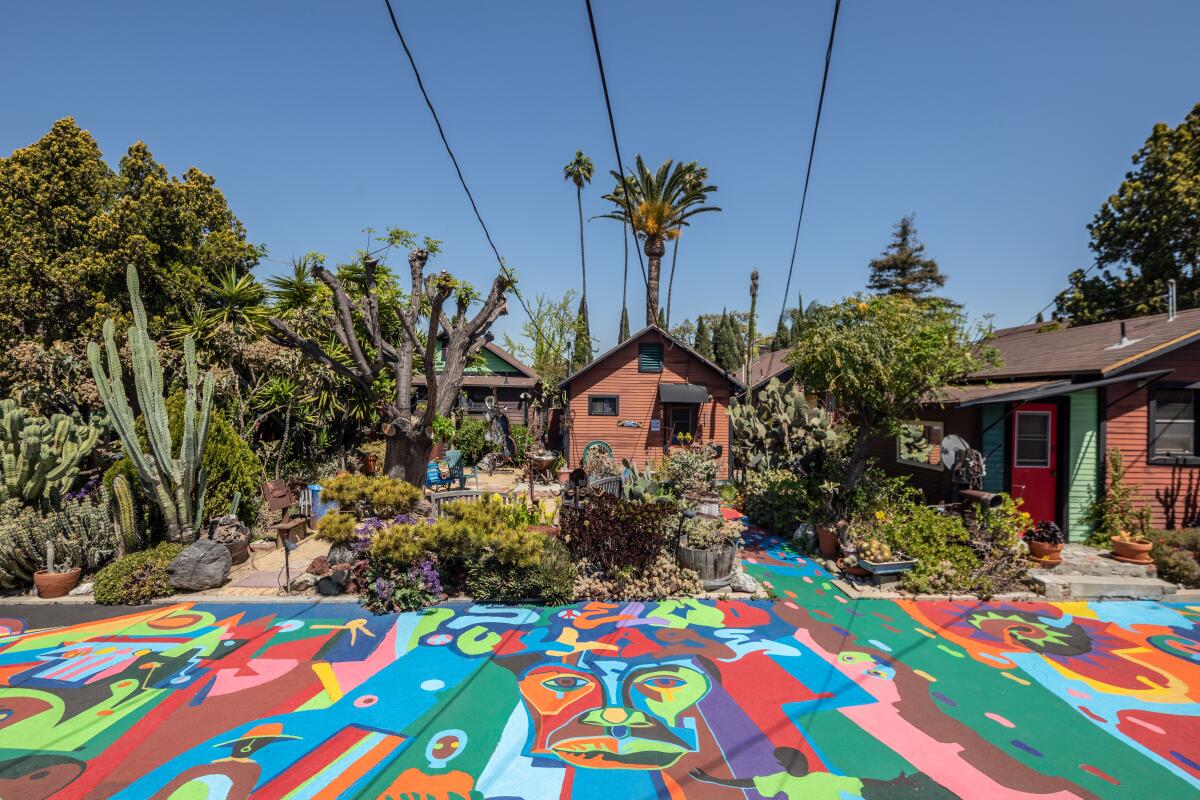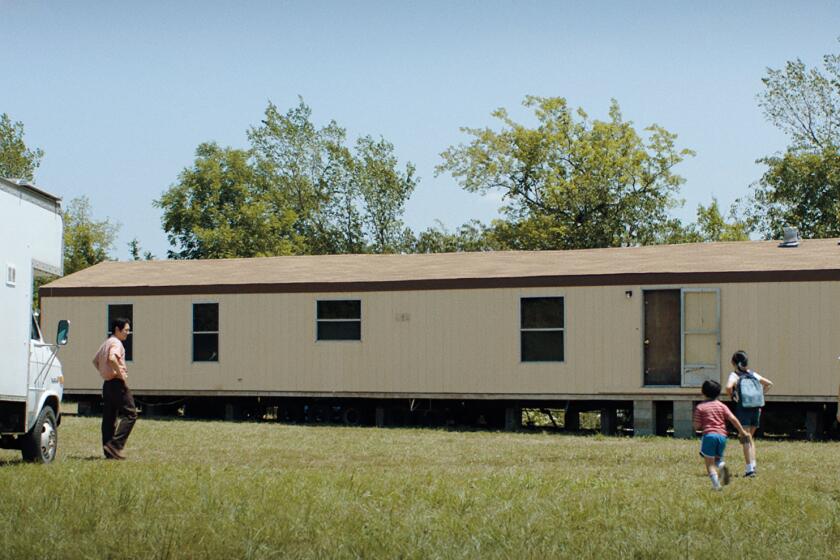Roderick Sykes, co-founder of L.A. Black art enclave St. Elmo Village, dies

St. Elmo Village co-founder Roderick Sykes, whose Mid-City Black art enclave and community center nurtured generations of creative minds and served as a gathering place for the founders of the Black Lives Matter movement, has died. He was 75.
Sykes had complications related to Alzheimer’s disease and died at home in the village, said his wife, Jacqueline Alexander-Sykes.
Sykes and his uncle, Rozzell Sykes, both visual artists, founded St. Elmo Village in 1969. The area originally consisted of a derelict collection of 10 Craftsman bungalows near Venice Boulevard and La Brea Avenue, which the two men cleaned up and used as a hub for like-minded people of all ages interested in exploring creative pursuits.
Occupying land that once served as silent film star Mary Pickford’s horse farm and named for the street it’s on, St. Elmo Village became a nonprofit in 1971. Sykes moved into one of the bungalows when he was 18 and lived alongside other residents who came and went until he died.

The enclave is a riot of colors and cactuses, with cheerful paintings on the walkways between homes and found-art sculptures and creative ephemera erupting from cracks and crannies. The community has a gallery, a meeting space, an art library, a photography workshop and darkroom, and a computer graphics workshop.
Seven of the original 10 units are occupied. The nonprofit operates an adjacent six-unit apartment building and is working toward turning a three-bedroom home into housing for artists in residence.
This last part will take $2 million, which St. Elmo Village is working to raise. Alexander-Sykes considers the realization of this dream a final tribute to Sykes’ vision.
“We are an example to the community of what you can do when you don’t say, ‘I can’t,’” said Alexander-Sykes, who took over as the director of St. Elmo Village when Sykes was diagnosed with dementia. “We are an example of what can be done when people of all different backgrounds come together.”
“Minari,” “Sound of Metal” and “Nomadland” depict environments that are transient and improvised, capturing our era of tumult and ambivalence.
St. Elmo Village is much more than a neighborhood art center, Alexander-Sykes said. Her husband helped it to become the creative heartbeat of the community — a polling place, an art school, a resource center, a spot for the vibrant exchange of ideas.
Over the years, in addition to his work as a muralist and photographer, Sykes occasionally served as the president of the board. He created teaching workshops in painting, drawing, sculpture, photography and African drumming. He conducted tours, staged presentations at local schools, did motivational speaking at colleges and universities, and interacted with politicians in service of the community.
He also swept the street and took out the trash, Alexander-Sykes said.
“Everybody is equal. You’re not above anybody else, or below everybody else,” she said, explaining one of Sykes’ core philosophies.
“People don’t talk to you if they think you’re the janitor; they talk to you if they think you’re the director,” Alexander-Sykes said, recalling how a few times people would come looking for Sykes and would just walk right by without saying a word as he was sweeping the street.
That kind of attitude struck Sykes as ridiculous, and he dedicated himself to creating an egalitarian community without a hierarchy of art-making or art makers. He believed that art could be found everywhere and in everything, Alexander-Sykes said. He knew there was an art to sweeping, an art in raising children and an art in cooking dinner. There never were — and still aren’t — any gates at St. Elmo Village, and everyone is welcome.
In July 2013, Sykes extended a welcome that would have historic implications. A few nights after George Zimmerman was acquitted of killing unarmed Black teenager Trayvon Martin, St. Elmo Village resident and activist Patrisse Cullors needed a place to gather about 40 people to grieve — and to plan.
The subsequent four-hour meeting laid the groundwork for what would become the Black Lives Matter movement.
“They asked Roderick if they could meet here, and he said, ‘Yes, it’s your space,’ and they considered us their home,” Alexander-Sykes said.
Roderick Sykes was born on Feb. 20, 1946, in St. Louis, to a single mother named Jerry Bruce. When Sykes was 9, his mother relocated the family to San Diego, where Sykes attended high school before moving to Los Angeles to work on his art.
Five augmented reality artworks launched Tuesday push the conversation on representation and historical accuracy in monuments.
He joined forces with his uncle, and in 1969 they hosted an art fair to raise the $10,000 they used as a down payment for what would become St. Elmo Village. They eventually bought the quarter-acre property for $60,000.
Sykes met his future wife in 1979 when she came to visit from the Bay Area at the behest of a friend, who was working as a publicist for the village. Alexander-Sykes is also an artist, and soon after she met Sykes, she invited him to visit her up north. Six months later, she packed her bags, moved to St. Elmo Village and never looked back.
“To be in a creative place, for me, it was a dream come true,” Alexander-Sykes said.
Sykes presented his work in galleries and also painted murals on the buildings of A&M Records, Pacific Telephone Company and CBA recording studio. He was part of a group of muralists recruited to paint on freeway walls and underpasses for the 1984 Summer Olympics.
Sykes is survived by Alexander-Sykes; daughter Tonya Sykes; sister Terry Ivery; three grandchildren; and 11 great-grandchildren.
The Getty Conservation Institute and the city are embarking on a three-year project to preserve landmarks that represent Black heritage across L.A.
More to Read
The biggest entertainment stories
Get our big stories about Hollywood, film, television, music, arts, culture and more right in your inbox as soon as they publish.
You may occasionally receive promotional content from the Los Angeles Times.










